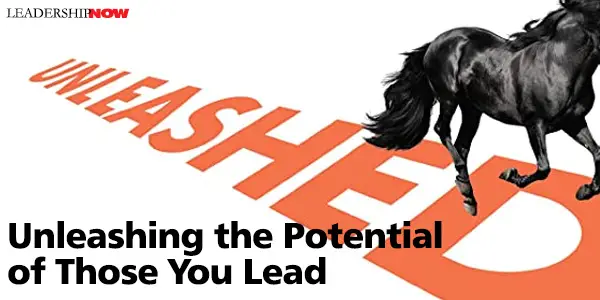 |
 |
07.24.20

Unleashing the Potential of Those You Lead
WHAT happens after you show up as a leader? Does the performance and potential of the people around you improve? In other words, it’s not about you. In Unleashed, Frances Frei and Anne Morriss want to change the conversation around leadership development from a focus on the leader to a focus on the people they are leading. And rightly so, because as they point out, the most important thing you can do as a leader is to build others up. To that end, they want to define this aspect of leadership as “empowering other people as a result of your presence—and making sure that this impact endures even in your absence.” Their point being that leadership really isn’t about how amazing you are, but how effective you are at unleashing other people. It is in that context hat they want us to look at leadership. I should note, however, that as a leader, self-improvement should be undertaken with a focus on the impact it has on those one is leading. The only way to improve the lives of those around us is to improve ourselves. It was Marie Curie that wrote, “You cannot hope to build a better world without improving the individuals. To that end, each of us must work for his own improvement, and at the same time share a general responsibility for all humanity, our particular duty being to aid those to whom we think we can be most useful.” Most leadership literature has this focus—at least implied. And it should go without saying that if one is thinking about how to improve the performance and potential of those they lead, it will improve your leadership. They go hand in hand. The impact of your self-improvement on others is the yardstick of its value. That said, there is an undue focus on the self in all of us. Although that affects everything we do, it’s not a leadership problem; it’s simply a human problem. But to be an effective leader, we must shift our focus off of ourselves. As the authors point out, “If you seek to lead, then your focus—be definition—shifts from elevating your self to protecting, developing, and enabling the people around you.” But often, we become focused on being seen as leaders than simply leading. Leadership makes us vulnerable as it exposes who we are. That’s the irony of many of the tactics we use to protect ourselves as leaders. They can backfire and undermine the perceptions we’re working so hard to cultivate. In order to look like leaders, we end up behaving like smaller, two-dimensional versions for ourselves. We obscure the parts of ourselves that real leadership demands, cutting off access to our full humanity. In the choice to insulate ourselves from the judgment of others, we disconnect from leadership’s core mandate to make those very same people better. Over and over again, you just can’t get away from the fact that effective leadership is built on humility. The authors are emphasizing what they call empowerment leadership. And this approach takes you outside yourself and creates a full-time job out of understanding and showing compassion and concern for those you lead. Only when you can imagine a better version of someone can you play a role in helping to unleash them. If you don’t have confidence in someone’s growth potential, then you can do many things with that person, but leading isn’t one of them. You can oversee, supervise, govern, persuade, and endure them. You can get through the day and instruct then to do things. This kind of approach is too often what we see being practiced and called “leadership.” Real leadership leads into the potential of others. To illustrate their point, they created the Rings of Empowerment Leadership. At the core is trust. “Trust creates the conditions for others to be guided by you.” They explain, once you build trust, you then “create a context where people around you can thrive.” And to create a context where teams thrive requires that you champion the differences of each member.
These first three competencies require that you be present for the action and limiting your influence. “The most successful leaders are influencing people far beyond their direct reach and are intensely aware that success depends on what happens in their absence. Which brings us to the outer rings of our model: strategy and culture.” From here, Frei and Morriss take us through each ring to develop the competencies and the mindset to become more empowering leaders. 
Posted by Michael McKinney at 01:33 PM
|
BUILD YOUR KNOWLEDGE
 

How to Do Your Start-Up Right STRAIGHT TALK FOR START-UPS 
Grow Your Leadership Skills NEW AND UPCOMING LEADERSHIP BOOKS 
Leadership Minute BITE-SIZE CONCEPTS YOU CAN CHEW ON 
Classic Leadership Books BOOKS TO READ BEFORE YOU LEAD |